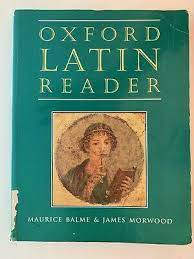Learning any language from the ground up is intimidating for anyone, let alone a language that has no native speakers. Don't let that dissuade you! Latin can actually be pretty easy to learn with the right tools, practice, and attitude.
In this article, I'll answer some of your questions about learning Latin and even give you some insight into what you need to know to make your Latin learning journey as successful and enjoyable as possible.
Pro Tip
By the way, if you’re looking for the best way to learn Latin fast… then look no further than Latin Uncovered. Latin Uncovered is an exciting online Latin course I’ve created teaches you Latin naturally through the power of story. Click here to find out more and for a free 7-day trial of the course.

Otherwise, here’s what we’ll cover in this article…
These are some of the most common questions new Latin learners ask themselves. To best answer them, I have broken down the article into sections based on these questions.
If you have a question you're particularly interested in, you can click on it below to jump ahead to that question.
If you’ve ever asked yourself any of the following questions, then this article is for you. If you want to skip ahead, just click the section that interests you.
Table of Contents
I'll start with some reasons to learn Latin, then move into more technical parts of learning the language. Finally, I'll end by giving you some resources to help you get started learning Latin today.
Why Learn Latin?

The first thing many language learners consider before starting or selecting a language to learn is the basic question of “why.” Why should I learn Latin over any other language? Even though it's a dead language it's an incredibly beneficial language for a person to learn.
1. Connection To Other Languages
One major reason to learn Latin is its connection to other languages.
When learning Latin, your knowledge of English and Romance language vocabulary will expand. Latin is the root of all the Romance languages, namely French, Spanish, Italian, Portuguese, and Romanian; thus much of the vocabulary is directly descended from a Latin root.
Similarly, English has a lot of Latin influences in its vocabulary. By learning Latin, your vocabulary in English and other languages will be enriched.
In the same vein, after learning Latin, it becomes much easier to pick up and study other languages. This includes Romance languages as well as other languages that are unrelated or more distantly related to Latin.
The Latin language has similar grammatical concepts and structures used in other languages. Typically, when learning Latin, you'll focus on grammar to understand how the language functions.
Once you're familiar with how grammar works in Latin, it becomes much easier and often quicker for you to pick up on in other languages.
Having a strong foundation in Latin grammar and syntax allows you to better understand how languages function, regardless of to what language family the language belongs.
A final note on connections to other languages: by becoming adept in grammar and syntax through Latin, you'll be able to improve your reading and writing in your own language.
2. Learn Specialised Vocabulary For Professions
In addition to improving your grasp of languages in general, learning Latin can also prepare you for the specialised vocabulary of many professions.
Numerous career tracks utilise explicitly Latin words and phrases or terms that directly come from Latin. For example, some legal terms and phrases, such as ex parte or habeas corpus are Latin words.
Science and medical terminology also either come from Latin or are Latin words. Consider the scientific names for animals, plants, etc., these are all Latin names.
Canis lupus is the scientific name for a wolf, but looking at the Latin words a Latin speaker would be able to determine the Latin translation which would be “dog wolf.”
Many other scientific and medical terms come from Latin, using Latin prefixes and roots. Familiarity with Latin vocabulary makes breaking down these otherwise foreign and complicated medical terms easier. Knowing Latin already will give you a head start on the lingo for these occupations and more.
3. Roman Culture
Needless to say, learning Latin will additionally lead you to explore more about Roman culture, history, mythology, and philosophy. This will even help make the process of learning Latin fun and entertaining when grammar doesn’t do it for you.
Key Features Of Latin

There are several features of Latin that you'll want to know before jumping into learning it. This will help you to prepare for learning as well as give you a preview of what the Latin language looks like.
One of the most important elements that you need to understand when learning Latin is that Latin is an incredibly inflected language. What this means is that the endings of many words change according to how the word is being used.
In English, there's a minute amount of inflection, recognised by the difference between singular and plural (or number) of nouns or the tense of verbs. For example, “coat” changes its number by the addition of “-s” at the end of the word: “coats.” The verb “walk” adds an “-ed” to indicate the past tense: “walked.”
If you'd like to know about the key features of Latin as well as its history, hit play on the video below. Otherwise, keep scrolling to read about the most important aspects of Latin.
Latin Noun Inflection
To get into the nitty and gritty of the inflection of Latin, let's first look at nouns and adjectives. Nouns and adjectives change their endings based on their gender, case, number, and declensions.
Grammatical gender for many languages is recognised by the feminine and masculine genders. Latin has an additional gender: neuter. These genders each have different endings according to the number, case, and declension they're in.
There are some patterns that some genders follow. For example, masculine nouns tend to be male individuals and feminine nouns tend to be female individuals, occupations, and concepts.
Number simply indicates whether the word is singular or plural. The difference between “cat” and “cats” is that “cat” has a singular number and “cats” has a plural number.
Case indicates the word’s function in the sentence. There are five main cases in Latin: Nominative, Genitive, Dative, Accusative, and Ablative. These represent the word’s role in the sentences, such as the subject, object of possession, indirect object, direct object, and the object of a preposition.
Declension is essentially the five different sets of endings that a noun can use. With all of these factors considered, a noun could have at most 10 different forms while adjectives could have 30.
Similarly, verbs have person, number, tense, mood, and voice, which all determine the ending and form of the verb.

Latin Verb Inflection
A verb’s person indicates the verb’s subject. There are three persons: 1st, 2nd, and 3rd. These are similar to the persons you learn about in literature.
First-person point of view is when the work is written from the point of view of the narrator, using the words “I” or “we.” Second person refers to the subjects “you” or “you all.” Third person refers to the subjects “he,” “she,” “it,” or “they.”
Number is the same as nouns and adjectives, namely, it identifies if the verb has a singular or plural subject.
Tenses for a verb will indicate the time in which a verb occurs. There are six tenses for a verb: present, imperfect, future, perfect, pluperfect, and future perfect:
- A present verb is happening now e.g “I am running.”
- An imperfect verb is when an action was happening continuously in the past, but is no longer happening e.g “I was running.”
- A future verb will happen later e.g “I will run.”
- A perfect verb has already been completed e.g “I ran.”
- A pluperfect verb refers to something that happened before another action in the past occurred e.g “I had run.”
- Finally, a future perfect verb is something that will happen at some point in the future after another action has been completed e.g “I will have run.”
A verb’s mood is the way in which a verb occurs. The three verb moods are indicative, imperative, and subjunctive.
- The indicative mood indicates a fact, statement, or question. For example, “We are leaving.”
- The imperative mood gives a command, such as “Leave!”
- The subjunctive mood refers to uncertainty, hope, or wish. Examples are “I hope that we would leave” or “Let’s leave.”
The voice of a verb indicates whether it is active or passive. An active verb indicates that the subject is doing the action, such as “The girl throws the ball.” A passive verb indicates that the action is happening to the subject, such as “The ball is thrown.”
Combining all of these factors, verbs can have around 122 forms depending on how they're being used in the sentence. Don't let that number scare you! Learning the verb forms isn't as daunting as it sounds (that's just the grammar villain messing with you!).
Latin Word Order
Latin has no strict order in which words should be in a sentence. In a simple English sentence, the word order goes like this: subject, verb, direct object. In Latin, there is a word order pattern, but it's not substantial and can often be ignored.
One of the most typical patterns seen in Latin is the placement of the verb. The main verb is often found at the end of the sentence.
Other verbs that are dependent on that verb may be near the main verb or be placed at the end of a dependent clause within the sentence. When you encounter a Latin sentence, go to the end to find the verb.
Because of the inflection of endings, noun-adjective pairs don't need to be in any order or even near each other. Often you will have these pairs separated and can match them based on their endings.
For prepositional phrases, there's a strict order of prepositions before nouns. There are certain circumstances in which noun-adjective pairs will sandwich a preposition, such as magna cum laude.
No “A(n)” Or “The” In Latin

Unlike many languages, Latin does not have the articles “the” or “a.” When reading and translating Latin, you will need to supply in English the “the” or “a(n).” This often throws new Latin learners as most languages have some form of these articles. Latin does have “this,” “that,” and other similar articles, though.
No Punctuation In Latin
Because Latin is so inflected and although it has no strict word order, there is no real punctuation used in Classical Latin.
The typical pattern of verbs being at the end of the sentence in the case of main verbs and at the end of clauses for other verbs is what allows Latin to avoid punctuation. If you see a verb, you will notice that likely you have reached the end of a sentence or the end of a clause.
Fortunately, you'll likely not have to deal with this lack of punctuation unless you get very far along in Latin. Most publications of Classical Latin texts and Latin language learning texts do include punctuation such as periods, question marks, and commas to aid in reading the texts.
What Do I Need To Know About The History Of The Latin Language?

Latin has evolved from the Roman Republic of the 5th-1st centuries BCE and before to its later Medieval and Renaissance forms to now.
When learning Latin it's important to know what type of Latin you want to learn. Grammatical concepts do change over time. Vocabulary that may have been used in one time period may not be used at all in another (that does not even account for spelling differences across time and geography!).
Archaic Latin
One of the earliest forms of Latin used was what is referred to as Archaic Latin. This form of Latin would be the latest likely Latin that you would come across. There aren't a lot of texts in Archaic Latin that have survived time, only fragments.
Classical Latin
The Latin used by the Romans of the late Republic and earlier centuries CE is what is referred to as Classical Latin. This is the form of Latin that is most widely taught in schools and universities.
If you learn Classical Latin, you'll be able to easily read Ceasar, Cicero, Catullus, Seneca, Sulpicia, and many other authors, poets, and playwrights that don't start with the letters C or S!
Medieval Latin
After the fall of the Roman Empire, the Latin language continued to evolve based on local language influences throughout Europe. This is the emergence of Vulgar Latin, which eventually morphs into Medieval Latin. This later form of Latin is a fairly common type of Latin for Medieval historians to study.
If you're planning to study this time period, Medieval Latin would be a helpful form of Latin to learn. There's newer vocabulary, different spellings for words, and several different corruptions of grammar and vocabulary from the Classical era to this point in time.
Since different regions in Europe by the time of the Medieval and Renaissance eras are using their own regional languages, Latin is mostly used in academia and the church.
These forms of Latin have a more specialised focus in their vocabulary and often don't have as complex a grammatical and syntactic structure as Classical Latin.
Before you jump into learning Latin, it would be beneficial to figure out which type of Latin you want to learn. If you want to focus on Ecclesiastical Latin, you would be lacking much of the religious vocabulary that you would want if you start with Classical Latin. Once you decide which type of Latin, from there you can find the correct sorts of resources that will guide you in learning Latin.
Click here to read more about Latin language history!
Is Latin A “Dead” Language?

In so far as the fact that no one natively speaks Latin, yes, Latin is a dead language. Additionally, no new vocabulary is being added for modern concepts and technologies. (Teachers coming up with their own words for “bathroom pass” and other modern ideas don't count!).
Unlike living language dictionaries, Latin dictionaries don't add new words, such as “low-key.” That doesn't mean that Latin is not a language that is still used daily. As mentioned before, you still see Latin being used in scientific, medical, and legal fields in terms and phrases.
You can see Latin being used in different capacities all around the world. Starting in the simplest ways, you see Latin being used continually in English, Romance, and numerous other languages. This is seen through the vocabulary as well as the grammar and syntax.
Additionally, Latin is used internationally for mottos of countries, schools, armed forces, etc. One of the best examples is E Pluribus Unum on the United States dollar.
Latin is still used in the Christian religion too. While this has changed over time, many Catholic masses are still being held in Latin and the Christian Bible is still printed in Latin as well as numerous other languages.
Thus, individuals interested in Christianity or Catholicism more specifically will seek out and utilise Latin.
In this sense, Latin may be dead, but you can't consider it extinct. Latin is used too often in many facets of western culture. Since it's not extinct, there is still incredible value in learning Latin.
Is Latin Hard To Learn?

Latin is as difficult to learn as any other language, especially if you're learning your first foreign language. There are several aspects of Latin that may make it hard for you to learn. Many factors may increase or decrease the difficulty level of learning Latin.
- Are you learning Latin as your first foreign language?
- Have you learned other languages, or languages closely related to Latin?
- What is your grasp of your native language’s grammar?
In addition, being a dead language severely decreases your ability to practice the language with native speakers.
Your Language Learning Experience
To be frank, this is a very personal question. Often people who have a systematic way of thinking or have a good foundational understanding of grammar will find Latin fairly easy to learn.
For others, learning Latin may be very difficult. What it really comes down to is having good discipline and practice with Latin in order to succeed.
The Level You Want
When learning Latin it's also important to consider what level of proficiency you're seeking. If you want a very basic understanding of Latin, that will be significantly different from wanting to become fluent in Latin. This will also be a way to help you measure and determine how difficult it will be for you to learn Latin.
The Languages You Already Speak
Overall, Latin can be a fairly easy language to learn if you are a native speaker of or have some degree of fluency in English and/or Romance languages. Since much of the vocabulary and grammar are related between the languages, it will be much easier for you to learn Latin with this background.
Latin Is Consistent And Logical

Typically, Latin grammar rules are very consistent. There are exceptions in any language to their grammar rules. Unfortunately, this is often seen in irregular words that are very frequently the most used words.
Although, the explanation for this is due to the fact that words that are used a lot, such as forms of “to be,” “to go,” etc., are more likely to be corrupted over time, creating exceptions.
Regardless of these exceptions and the irregularities found here and there in Latin, it is a fairly rule-bound language. Once you understand the basic grammar and syntax rules, it's mostly a matter of plugging in words and letters to create your sentences.
Along with consistent grammar rules, there are patterns found all throughout the Latin language. While above we discussed how there are over 100 forms of a single verb, the good thing is that those forms follow patterns and are shared for all regular verbs.
By slowly being introduced to these patterns and mastering them, the numerous forms of verbs and nouns will become a lot less daunting. Plus you may impress yourself down the line by the sheer number of forms you have learned without even realising it, especially if you learn through story.
How Can I Get To Grips With Latin Pronunciation?

Even though Latin is a dead language, we do know how Latin is pronounced. The main concern is what type of Latin are you trying to pronounce!
As Latin has changed throughout the centuries, so too has Latin pronunciation. Fortunately, Latin has only 23 letters, many of which are shared with all languages that use a form of the Roman alphabet – think about it, they got their alphabet from Latin!
There are technically four ways in which you can pronounce Latin: Ancient Latin, Church Latin, Northern Continental Latin, and English Latin.
Church And Northern Continental Latin
Church and Northern Continental Latin are specialised forms of Latin used for specific purposes, namely in the Catholic church and by early scientists, mathematicians, and other academics, respectively.
English Latin
English Latin is essentially using English pronunciation for Latin words and names, such as Julius Ceasar (i.e. in Ancient Latin it would be pronounced “Yoo-li-us Kai-sar” while in English Latin we pronounce it “Joo-li-us See-sar”).
If you want to learn the pronunciation of Church Latin, look no further than Italian pronunciation. Since Ancient Latin, however, is the more commonly learned pronunciation of Latin, we will focus on that.
Ancient Latin
The best thing about Ancient Latin pronunciation is that it is incredibly consistent with little to no exceptions to pronunciation.
Unlike other languages where you may need to consider certain combinations of letters and how their pronunciation may change, in Latin, the pronunciation of letters often do not change.
In addition, every letter is pronounced – there are no silent g’s like “gnome” in English.
Vowels
Latin vowels are pronounced as either long or short. In some Latin texts, dictionaries, and textbooks the vowels will be marked with a long mark above long vowels and no mark above short vowels.
The best way to understand how best these vowels are pronounced is in comparison to how these vowels are pronounced in English words. See the following examples:
- /a/ – ‘a’ like in “apart”
- /ā/ – ‘a’ like in “father”
- /e/ – ‘e’ like in “get”
- /ē/ – ‘e’ like in “they”
- /i/ – ‘i’ like in ‘hit’
- /ī/ – ‘i’ like “ee” in “green”
- /o/ – ‘o’ like in “on”
- /ō/ – ‘o’ like in “home”
- /u/ – ‘u’ like in “luck”
- /ū/ – ‘oo’ like in “boot”
Consonants
Most Latin consonants are pronounced the same as English consonants. The only exceptions are due to the fact that Latin does not have as many letters as English. Namely, “j,” “w,” and “y” are not present in the Latin alphabet. In addition, “k” is very rare in Classical Latin.
This doesn't mean that these sounds from these English consonants are not present in Latin, instead many are heard from other Latin consonants.
For example, “i” in Latin at times will be pronounced as an English “y” and “v” in Latin is pronounced like the English “w.”
See below for the pronunciation of Latin consonants that differ from English consonants:
- /c/ – ‘k’ like in “kite”
- /ch/ – ‘k’ like in “kite”
- /g/ – hard ‘g’ like in “get”
- /q/ – hard ‘q’ like in “quiet”
- /v/ – sometimes seen as /u/ in texts, sounds like ‘w’ as in “water”
- /i/ – used when before another vowel, sounds like a ‘y’ as in “yet”
Diphthongs
Diphthongs, which are two vowels placed together to form one sound are commonly used in Latin. While that may seem like a strange concept, these are also common in other languages. In English there are eight diphthongs /aɪ/, /eɪ/, /əʊ/, /aʊ/, /eə/, /ɪə/, /ɔɪ/, /ʊə/. Clearly, these are not all letters used in English.
Instead, these are the phonetic symbols to represent the sounds. In English, many different vowels can be used to form these eight diphthongs. Fortunately, in Latin there are six diphthongs all with one way to spell them.
See the following list of Latin diphthongs:
- /ae/ – long ‘i’ or ‘eye’ as in “aisle”
- /au/ – ‘ow’ as in “about”
- /ei/ – ‘ay’ as in “reign”
- /eu/ – ‘oo’ as in “boot”
- /oe/ – ‘oy’ as in “oil”
- /ui/ – ‘wwi’ as in “quit”
Syllables
The last thing you need to consider is where to break down the Latin words into their sounds or syllables. For the most part, Latin syllables are composed of a consonant-vowel pair, in that order. Some syllables do start, or even only consist of, a syllable.
Two non-diphthong vowels next to each other form two separate syllables. So in this circumstance, the next syllable will start with a vowel. Some syllables may end in consonants, but typically these are at the end of words or in the case of double consonants.
See below for some examples:
- consonant+vowel
- cū-ra
- vowel start
- au-di-ō
- vowel+consonant & double consonant
- laet-us
- bel-lum
6 Pitfalls To Avoid As A Beginner Latin Learner

Unfortunately, learning a new language can be incredibly intimidating. Often there are traps, or pitfalls, that beginning learners can accidentally fall into.
Here you'll discover some of those that you'll want to avoid. That way you can recognise early on if you are doing it and stop before you get frustrated and give up!
Don’t Try To Learn Too Many Things At Once
As with any language, there are a lot of vocabulary and grammar concepts. Focus on learning simple concepts one at a time, while thoroughly practicing them until you have mastered them. Then start to slowly add additional vocabulary, grammar, and syntax as you continue on.
Don’t Skip Practicing!
As the saying goes, practice makes perfect. It's crucial that you make sure you practice vocabulary and grammar as you're learning Latin. This ensures that you are storing all that information in your long-term memory.
If you move on too quickly to learn something new and don't take the time to practice it, you will likely forget what you just learned before long.
Don’t Look Up Every Word You Don't Know
Use the context of the sentence to help you figure out the word. Or even consider any English (or other Romance language) cognates. Cognates are words whose roots come from other languages.
For example, if you see the word mater, thinking of similar English words you may think of “maternal” or “maternity.” From that, you can assume that mater has something to do with motherhood or mothers.
Don’t Forget To Review The Material
Just like practice, studying vocabulary and grammar concepts is vital for the longevity of your Latin knowledge. Bringing back older vocabulary and grammatical content in your practice will help to ensure that you're not forgetting important Latin concepts.
Don’t Advance Too Quickly In Reading
You won't go from simple sentences to reading Cicero in one week. Be sure to pace yourself and find reading materials suited to your current level of Latin knowledge.
It's easy to find reading materials that are from Ancient Roman authors as well are more contemporary Latin books and stories at many different levels. This will ensure that you practice your Latin reading at a level you are at while also not frustrating you due to overly difficult material.
Reading at your level is one of the 10 rules of StoryLearning.
Don’t Compare Your Progress To Others’ Progress In Modern Language Learning
While other language learners may learn how to order food from a restaurant, that doesn't mean you'll be learning Latin the same way. Since Latin focuses on grammar and syntax early on, you'll be able to form and read more complex sentences before people learn that in other modern languages.
What's The Best Way To Become Fluent In Latin?
Becoming fluent in Latin will take time and dedication. This is not a task that will happen overnight or within a week. Consider how many years it takes children to fully speak and comprehend their native language!
While you may want to focus on the negatives and previously mentioned pitfalls, it's important to instead turn to the best practices that will help you become fluent in Latin.
1. Enrol In Latin Uncovered To Learn The Fundamentals (And More!)

Latin Uncovered, like with my other courses, teaches you Latin through the power of story. People are hard wired to learn through stories and my course takes that principle and uses it to help you achieve your language learning goals. You will read and listen to stories in Latin and before long you will be amazed at your progress. Click here for a free 7-day trial of the course.
2. Set Goals

The next item on your list should be to set yourself some goals. These should be short and long-term goals. Consider your time frame. By what end date do you want to be considered fluent?
From there, you can set yourself some milestones that you want to reach. And that will help you in creating your shorter-term goals of daily, weekly, and monthly goals.
Speaking of fluency, one of the first things you'll want to do is to decide what “fluent” means. To be perfectly honest, fluency is subjective and up for debate. Typically though, fluency is defined by the ability of a speaker to fully express their thoughts in another language fluidly without pauses or hesitation.
This becomes slightly more difficult to define with Latin as, likely, you won't be seeking to speak Latin. Instead, the measure of fluency in Latin will be more based on your ability to read, comprehend, and write in Latin without the frequent use of a dictionary to find words or a grammar book to check grammar concepts.
3. Learn Phrases

Instead of learning individual Latin words, learn phrases instead. If you only focus on individual words, you can struggle when the time comes to put them together.
By learning these chunks of Latin, you won't need to build all your sentences from scratch. Learning phrases will also help to cement certain grammatical or syntactical concepts on in your brain.
4. Don't Get Hung Up On Grammar Or Be Afraid To Make Mistakes

When a child learns to walk they fall down. When they learn to talk they misspeak. So it is with language learners of any age.
If you want to head in the direction of fluency you have to make mistakes. In fact, the mistakes you make will often be hilarious and some of your best language learning memories.
The point is you need to be willing to make a mistake. The good news is that it will probably be really funny when you do.
Instead of getting hung up on mistakes, focus on consistency, which is a major factor in being fluent in a language. It can't be emphasised enough, PRACTICE. Don't let the inconsistency villain persuade you that it's ok to slack off.
To become fluent you need to practice Latin in many different ways using different resources. You should be looking at and practicing Latin daily to keep it fresh to be eventually stored in your long-term memory.
5. Speak Latin

Even though today Latin is used as a written language primarily, you may want to consider finding courses or communities that intentionally practice speaking Latin.
Some Latin courses at various levels are focusing on learning Latin through speaking, much like a modern language. This will also help you with the speed at which you produce Latin in your brain.
When writing out Latin, you may find yourself scrolling through your internal grammar catalogue to find your correct form. When conversing in Latin, however, more common forms and phrases will more quickly become second nature to you.
What Are The Best Resources To Learn Latin Online?
Fortunately, people have been learning Latin for a long time and language learning has only evolved for the better. This means there is a wealth of resources to learn Latin and so many different ways to engage with the language, which is helpful for diverse learning types.
Online Latin Course: Latin Uncovered

Latin Uncovered – My beginner Latin course will teach you everything you need to know about Latin without textbooks and direct grammar instruction.
And because the course uses the power of story to help you learn, it is not only effective but extremely fun. Click here for a free 7-day trial of the course.
In each story, the grammar and vocabulary are integrated, rather than directly taught through instruction. This is a great way to learn grammar without knowing you are learning grammar.
Learn Latin Online
Nowadays, there are a surprising number of ways to learn this “dead” language online. Here are a few suggestions.
Latin Language Learning Blogs
My Latin language learning blog covers topics like Latin grammar and Latin verb conjugation in more detail. They are the perfect way to diver deeper on a topic and help you in your journey toward fluency.
Websites And Apps
There are also several digital learning platforms that you can use to help learn Latin. Some language learning apps have Latin courses that you can take. These will help you practice vocabulary, reading, pronunciation, and composition of Latin.
Additionally, there are websites in which there are vocabulary flashcards that you can use to help drill vocabulary. Some of these already have sets of vocabulary that people have made, or you can make some yourself.
Latin Podcasts And Video
Other digital sources that you can use are Latin podcasts and videos. These are good options to hear Latin used aloud. Some videos and podcasts may be specifically grammar-oriented, giving tutorials and mini-lessons.
Others are simply audio content that is in Latin. These are all great opportunities to learn Latin, especially for learners who learn better from auditory-based learning.
Learn How To Speak Latin

iTalki is a great resource for language learners because it connects you with language teachers so you can practice speaking what you are learning no matter where you are.
There is also a vibrant community of language learners you can meet and practice with online.
Latin Dictionaries
As with any language, you’ll want to have a quality dictionary. There are several good options for physical and online Latin dictionaries.
Typically when looking at online dictionaries, you’ll want to favour dictionaries that do have a physical version as well. The trap in online dictionaries is that often they are based on Google Translate, which is not a good source for accurate word definitions.
Latin Textbooks

You will also want to have access to a Latin textbook. Some popular Latin textbooks are the Ecce Romani and Cambridge series which are often used in high school-level Latin courses.
These two textbook series follow Roman families and have a story throughout the books.
College-level courses may use these but often are heavier on grammar and less about one cohesive story. Popular choices are Wheelock’s Latin and Shelmerdine’s Introduction to Latin.
Latin Readers

Beyond textbooks, you will also want to consider using Latin readers. These are books that will help you improve your reading and reading comprehension.
Some Latin readers are edited or abridged versions of Latin from leading Roman authors or orators. Others are more modern stories that are often made for various age groups.
If you are feeling adventurous, there are several modern novels that have been translated into Latin that you could use as well. Latin readers help give Latin learners a wider array of literature and stories to read and practice Latin reading.
With these resources, using more than one is a must! This will ensure that you are getting a wider variety of vocabulary and engaging your mind with different learning practices.
This will keep you interested in learning Latin even on days when you might not be in the mood. Switching up your language learning resources will only make your Latin journey richer. As long as you actually use them all of course and don’t turn into a hoarding villain!
Now You’re Ready To Start Learning Latin!

So there you have it. While some might say Latin is a hard language to learn, the truth is that it is a systematic language with very few exceptions that you can learn if you go about it in the right way.
If you take time each day to work on your Latin by immersing yourself in story, making sure to use what you learn, and practicing intentionally, you can do it.
And if you sign up for my course, Latin Uncovered, you will be able to do it even faster, better, and by having a ton of fun. Click here for a free 7-day trial of the course.
I hope you’ve found this post helpful!
If you have a friend learning Latin, please take a moment to share this post with them, it would mean a lot to me!
Recommended Articles

















































